
Jim Bishop’s Steep, One-Acre Garden
In the first of this two-part series, you'll meet renowned San Diego horticulturist Jim Bishop and see four of seven gorgeous garden spaces surrounding his 1930s Spanish hacienda home: streetside, courtyard, veranda and walled garden. You'll also learn how he handles challenges such as fog, gophers and steep, rocky terrain.
In Part Two, see Jim's ingenious bottle walls, artistic mosaic pathways and large mandala ringed by gabions (stone-filled wirework containers).
A Garden Unlike Any Other
Jim Bishop's steep, one-acre terraced garden in San Diego is unlike any other, except perhaps Jardin Exotique d'Èze near Monaco, overlooking the Mediterranean.
"But there, they have to dig basins into solid rock to plant anything," recalls Jim, who has visited it and many other gardens worldwide. Not that his own garden lacks rocks. "Every time you dig a hole, you end up with a bucketful," Jim says. Because his garden is on a bluff overlooking the San Diego River valley---no surprise---his rocks are smooth and rounded.

Euphorbia ammak and agaves
Jim's Ongoing Challenges
Jim, a retired garden designer and past-president of the San Diego Horticultural Society, sculpted the terrain below his 1930s Spanish colonial home over the past 22 years. He and partner Scott Borden contend with rock slides, fog that causes succulents to rot, and erosion.
There's no wheelbarrow access, so they have to hand-carry tools, nursery pots and supplies. Gophers eat roots and undermine steps and landings. Only recently---the last four years---have Jim and Scott tackled landscaping the north-facing bluff's sunniest spot, a level area ten stories and 300+ steps below the house. "We live in Mission Hills," Jim says. "The bottom of our property is in Mission Valley."

Stairs lead past a bottle retaining wall and a large Aloe thraskii
Far and Wide
It's often on organized tours---not just local groups, but also visiting horticulturists, landscape architects, and garden designers. I've followed the progress of this remarkable garden for 14 years, meeting Jim and Scott when I covered it for San Diego Home/Garden magazine ("Steep Solutions: Mission Hills homeowners carve out a glorious garden," June, 2006). I've also written about it for the San Diego Union-Tribune, Better Homes & Gardens, and Sunset, and it's in all three of my succulent books.
Attention to Design
Jim reminded me recently that on my initial visit, I shot more photos of potted succulents than anything else. Well, sure, back then I was working on my first book, Designing with Succulents, and a good succulent garden was golden.

Veranda garden as shown in Designing with Succulents, 1st ed.
When Jim saw the book's two-page spread of his veranda garden, he realized he'd overlooked a keynote of good design: pattern repetition. He could have effectively echoed a wall tile's eight-pointed star with plants with pointed leaves. So Jim switched the containers to agaves. His veranda agave collection now numbers 35---and that doesn't include in-ground specimens.
Plants and Rocks
It's difficult to say how many different succulents, tropicals, natives and Australians grow on the property. Certainly thousands. They range from a towering Torrey pine and aloes to dainty air plants (tillandsias), vines and---where sun is adequate---cacti.
Jim is an artist as well as a plantsman, and over the decades he's developed mosaic skills. What began as cobbled landings have evolved into elaborate designs that incorporate terra-cotta roofing tiles. The latter are leftover "from when we installed solar panels," Jim says.

Mosaic of terra-cotta roofing tiles
Bottle Retaining Walls
And then there are the bottles. Jim's preferred color for garden accessories (such as ceramic glazed pots) is blue, so I'd assumed that's why all sorts of blue bottles border stairways and ornament terraces, and of course are a fine example of repurposing. I learned recently that those were not Jim's only reasons. As he explains in the second of my videos about his garden, typical blocks for terraces weigh 60 pounds. Having to carry one "five stories below the house really wears you out," Jim says. "But you can always carry, whenever you come down the hill, a handful of bottles."

Jim estimates there are 10,000 bottles in the garden. Here, they shore up a terrace planted with Gasteria grande.
Bishop Garden: Six Areas
The garden's distinct areas incorporate succulents as well as ornamentals that thrive in San Diego's mild, often damp coastal climate. Typical of gardens that face north, this one lacks sun, especially in winter---which, Jim explains, is among its many challenges.
Streetside
This comparatively small, south-facing front garden once was roses, but "they burned in the winter," Jim says. And because of brick hardscape, most plants are in pots---a difficult environment for thin-leaved ornamentals but not for succulents. The pots-atop-pavers situation also is true of the courtyard and veranda garden areas.

Front garden with Aloe vanbalenii, Agave 'Blue Glow', kalanchoes and more.
Courtyard
A wrought-iron gate leads into a patio sheltered on three sides by the house and on the fourth by a garden wall topped by brick latticework. In gaps is Jim's tillandsia collection. Here, too, is a table for outdoor dining and an arched fountain with blue, white and yellow Mexican tiles---a stylistic note repeated throughout the house and garden.

Tillandsias amid bricks benefit from moist air and a northern exposure.
Veranda
Along the home's top level is a 1,500-square-foot veranda paved with terra-cotta tiles. The 180-degree view is to the north, across Mission Valley; to the west where the river meets the sea; and to eastern foothills. Sounds include a fountain's splash, the chittering of hummingbirdsmuted, and roar of Interstate 8 from the valley below. Large pots brim with succulents and tropicals.

Veranda garden in winter
Walled garden
Steps in a tower designed by architect Marc Tarasuck during an extensive remodel 20 years ago, lead down to where "the coldest swimming pool on the planet" once was, Jim says. This rectangular area along the home's north retaining wall now has a thick-walled, open-air casita with archways that frame a fountain and sunken garden.
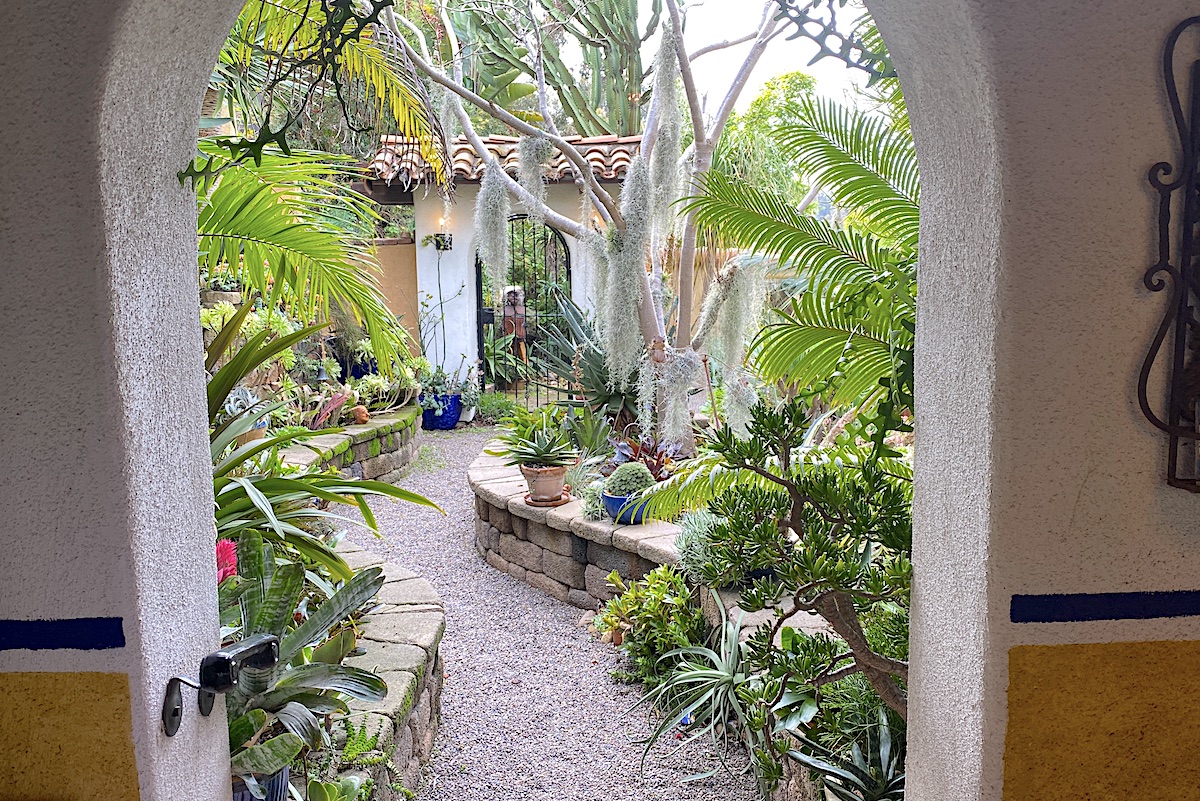
Spanish moss hangs from a tree in Jim Bishop's walled garden
Terraced garden
The steep hillside below the house is the largest garden area, and half of it is native chaparral. Switchback steps weave past terraces containing a botanical collection of plants, each with its own story. And no trip into Jim's garden is complete without discussing (and lamenting) gophers. "Last month I caught five," Jim says.

Gophers occasionally undermine large succulents, like this Agave americana 'Marginata', shown on a damp day.
Mosaic garden
The garden's latest addition is a large mosaic mandala surrounded by rock-filled gabions with flat stone seats. Jim's aloe garden is along the east side; his cactus garden on the west. Between the circle and the property's northernmost fence are Australian trees that Jim hops will eventually conceal an adjacent hotel's parking garage.

A young, newly planted Aloe 'Hercules' in the center of the mosaic mandala will attain 30 feet in height.
bishop garden Gallery: photos and plant id's
related info on this site
Succulent Landscapes
Succulent Landscapes Design ideas and must-dos for your yard’s transformation Want to transform your yard into a low-maintenance, low-water succulent garden? This page guides you to helpful info on this site and on my YouTube channel. Before you purchase plants or pick up a shovel, do obtain my book Designing with Succulents (2nd ed). It’s mainly about…
Succulent Container Design
Succulent Container Design Design ideas and must-dos for beautiful, easy-care potted succulents Here you’ll find info on succulent container design in articles and videos. Scroll down to see what interests you and best meets your needs. Click to see my gallery of 150+ floral-style arrangements! Succulent Container Gardens, How-To Welcome to the most comprehensive info…








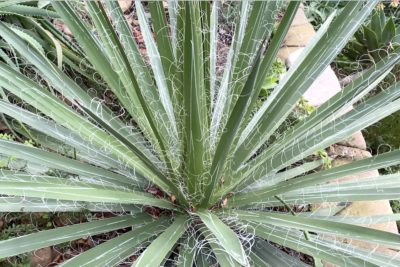



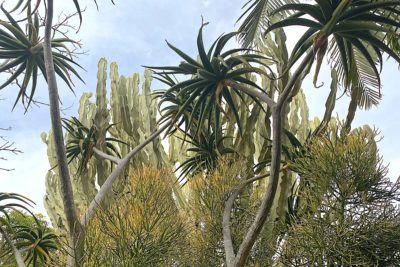



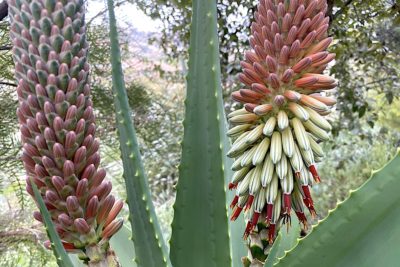

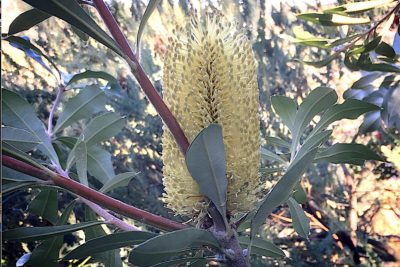





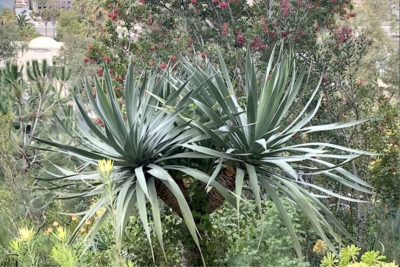



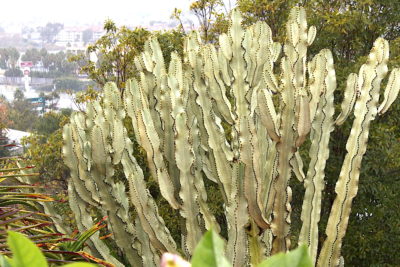

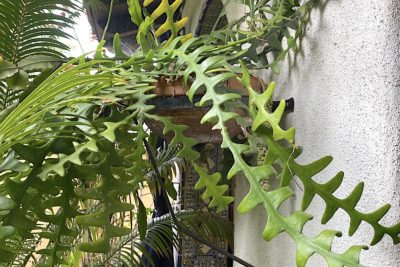
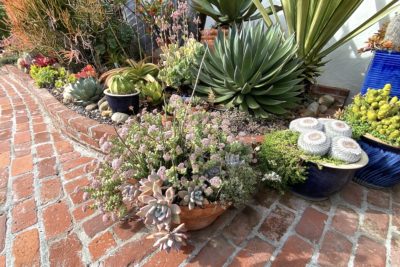






















Wow, I love Jims garden! It’s so creative and diverse. Please keep posting these wonderful and inspiring videos!
I am just starting up a succulent garden myself, so still have a long way to go!
Hi Marion! Thank you for your comment. I’m so glad you enjoyed the videos. Yes, creative, diverse…and maybe a little crazy? LOL
GREAT article!!!!!! Jim and his garden(s) look terrific! Thanks for this marvelous, informative, and entertaining story.
Hey Matt! So nice to hear from you. You have an amazing eye for design. Jim will doubtless be pleased!
I loved this entire post, full of lovely ideas. Now I must get out in my garden and see what I can create there!
Many thanks Debra,
MA
Thanks, MA — Hopefully yours isn’t as steep!
It’s rare that the word “charming” is justified — but your twin videos deserve the accolade… and more! Learned a lot, enjoyed them a bunch, and was charmed by the garden — and the interviews. Wonderfully done. THANKS!
Thank you! And indeed I would, without hesitation, use the word “charming” to describe YOU, my friend! — Debra
That’s a lovely garden. I am always envious of the variety of succulents and cacti available to you in the USA. In Australia we are much more restricted of course.
The mandala and other creative ways of landscaping are really inspiring. I am hoping to do something interesting with paving in my garden as I progress with my re-landscaping project. I wouldn’t have thought of using bottles in paving, but they look great.
Thanks, Ruth! Yes, bottles and stones…who knew? Amazingly they’re both functional and appealing. I hope you’re well away from the awful wildfires. Such a tragedy for Australia.
I LOVED the two videos you did at Jim Bishop‘s! You connected the dots for me…I got to see that garden on the Mission Hills Garden Tour a few years ago and was sooo impressed. But, I didn’t have a guided tour as you just gave me. And there were tons of other people in the garden that day.
Also, I started following Jim on FB a couple of months ago and have really enjoyed his photos. However, I had no idea he owned that house in Mission Hills.
So, thank you so much for putting this all together for me.
Thanks, Pat! For others who’d like to follow Jim on Facebook (well worth doing), here’s the link.
Very inspiring! Now I’m tempted to leave work early today and get out in the garden. Did Jim mention how he managed to collect all the blue bottles?
Hi Hans! Jim has friends who routinely save them for him. One friend gets them from a fellow who drinks beer that comes in blue bottles. Bud Light Platinum.